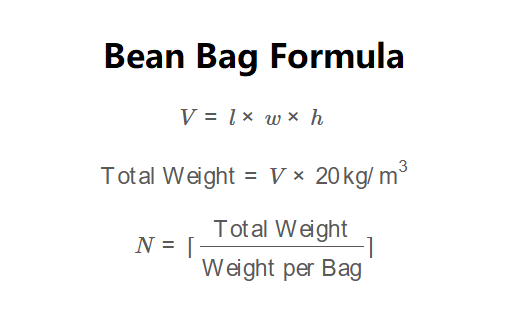1. What is a Bean Bag Filling Calculator?
Definition: This calculator determines the total weight of fillers needed and the number of filler bags required to fill a bean bag, based on its dimensions (length, width, height) and the weight per bag of fillers.
Purpose: It is used to ensure you purchase the correct amount of bean bag fillers, providing optimal comfort and avoiding over- or under-filling.
2. How Does the Calculator Work?
The calculator uses the following formulas:
Volume of the Bean Bag:
\[
V = l \times w \times h
\]
Total Weight of Fillers Needed:
\[
\text{Total Weight} = V \times 20 \, \text{kg/m}^3
\]
Bags of Fillers Needed:
\[
N = \lceil \frac{\text{Total Weight}}{\text{Weight per Bag}} \rceil
\]
Where:
- \( V \): Volume of the bean bag in cubic meters
- \( l \): Length of the bean bag
- \( w \): Width of the bean bag
- \( h \): Height of the bean bag
- Total Weight: Weight of fillers needed in kg
- \( N \): Number of filler bags needed (rounded up)
- Weight per Bag: Weight of one bag of fillers in kg (default is 1 kg)
Unit Conversions:
- Meters (m): Base unit
- Centimeters (cm): 1 cm = 0.01 m
- Inches (in): 1 in = 0.0254 m
- Feet (ft): 1 ft = 0.3048 m
Steps:
- Enter the length, width, and height of the bean bag, selecting the unit for each.
- Enter the weight per bag of fillers (default is 1 kg).
- Convert all dimensions to meters for calculation.
- Calculate the volume using \( V = l \times w \times h \).
- Calculate the total weight using the density of 20 kg/m³.
- Calculate the number of bags by dividing the total weight by the weight per bag, rounding up.
- Display the total weight and number of bags needed.
3. Importance of Bean Bag Filling Calculation
Calculating the correct amount of bean bag filling is crucial for:
- Comfort: Ensures the bean bag is neither too hard nor too soft.
- Cost Efficiency: Avoids purchasing too much or too little filler.
- Durability: Proper filling prevents strain on the bean bag cover and maintains its shape.
4. Using the Calculator
Examples:
- Example 1: Length = 1 m, Width = 1 m, Height = 0.5 m, Weight per Bag = 1 kg:
- Volume: \( V = 1 \times 1 \times 0.5 = 0.5 \, \text{m}^3 \)
- Total Weight: \( 0.5 \times 20 = 10 \, \text{kg} \)
- Bags Needed: \( \lceil 10 \div 1 \rceil = 10 \)
- Example 2: Length = 100 cm, Width = 80 cm, Height = 50 cm, Weight per Bag = 2 kg:
- Volume: \( V = 1 \times 0.8 \times 0.5 = 0.4 \, \text{m}^3 \)
- Total Weight: \( 0.4 \times 20 = 8 \, \text{kg} \)
- Bags Needed: \( \lceil 8 \div 2 \rceil = 4 \)
5. Frequently Asked Questions (FAQ)
Q: Why is the density assumed to be 20 kg/m³?
A: This is an average density for common bean bag fillers like polystyrene beads, ensuring a comfortable fill level.
Q: Why are the number of bags rounded up?
A: Rounding up ensures you have enough filler to completely fill the bean bag without leaving gaps.
Q: Can I use different units for length, width, and height?
A: Yes, the calculator converts all inputs to meters for calculation and displays the results accordingly.
Bean Bag Filling Calculator© - All Rights Reserved 2025
 Home
Home
 Back
Back
